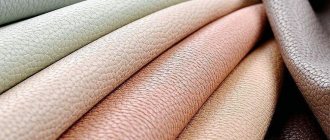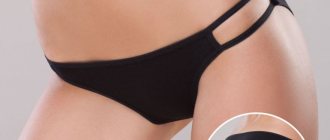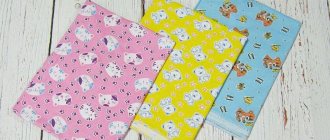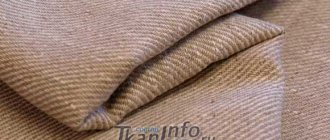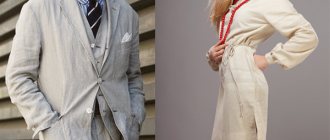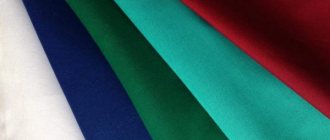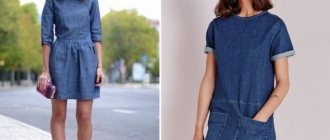Natural fabrics for summer dresses
Natural materials are good because they “breathe” - they allow air to pass through well, and the body feels comfortable in such clothes. They absorb moisture well and have excellent thermal insulation qualities - they are not hot in summer and not cold in winter.
Such materials are expensive, things made of natural silk and linen are especially valued.
But natural materials also have disadvantages:
- they wrinkle easily and lose shape when worn;
- some materials are highly hygroscopic and take a long time to dry;
- they lose color easily and fade when washed;
- Pellets may appear on the surface.
Let's consider natural fabrics for the summer that are most suitable for sewing dresses.
Selection by color type
The most common color type is Summer.
Youth summer dress
Peculiarities:
- Tenderness, thinness of the skin, its coolness;
- Redness and capillaries, gray-brown freckles;
- Pinkishness and uneven blush;
- Tanning speed;
- Light brown, ash dark brown hair color;
- Hair burning under the sun's rays;
- Early gray hair;
- Dimness and cloudiness of the eyes - blue, gray-blue, blue tint;
- Light brown eyebrow color.
Choosing a wardrobe.
- Romantic style of clothing. Outfits with frills, ruffles and other decorative elements are perfect;
- The color of the wardrobe is blue. The best option for choosing clothing colors is smoky blue, denim blue, blue-gray, soft blue and other shades of color;
- Purple, dark pink and red colors will take their rightful place in the wardrobe;
- Natural white will not work. Preference should be given to color variations - “eggshell”, “bleached oak” and other shades;
- Brown clothes with a gray undertone;
- The choice of light shades for sundresses, shirts - mint, soft pink, violet, cream palette.
Cotton fabrics
This group includes chintz, calico, staple, denim, flannel, satin, cambric. Denim is a thick cotton fabric with a characteristic weave, dyed blue on one side. A lightweight version of denim is jeans. As a fabric for summer, denim is too thick, although a stylish dress can be made for not too hot weather.
Calico, chintz and cambric are lightweight fabrics for the summer, but now they are rarely used for sewing dresses, as they wrinkle easily and quickly lose their attractiveness from frequent washing.
An excellent material for a dress is staple. A practical and beautiful staple today is widely used by designers. Modern staple has a mixed composition and is a combination of cotton and lavsan (or viscose). The material is light, pleasant to the touch, quite dense and practical, and drapes well. If you are thinking about what material to make a summer dress from, staples are ideal for this purpose.
Silk
Delicate flowing silk is the best fabric for summer, especially hot summer. Both artificial and natural silk are very pleasant to the touch, almost imperceptible on the body. Natural silk is very expensive, but modern artificial analogues are practically not inferior to it in quality.
Silk is an ideal fabric for a summer sundress, a dress with a wide skirt of any length, a wrap dress or a Chinese-style outfit (in this case, you need to choose the appropriate pattern).
Linen
Linen looks very stylish, it is not hot even at very high temperatures, but it wrinkles easily and strongly, this is the main disadvantage of linen. This is a suitable fabric for a floor-length summer dress with a straight silhouette. Undyed linen is often decorated with borders, embroidery, and ornaments at the neckline and at the bottom of the garment and looks very elegant and attractive.
Rami
Chinese nettle fibers are used to make ramie. The plant has been used for the production of textile fibers for a long time. Externally, ramie resembles linen, is easy to dye and wrinkles easily. The material is durable and can withstand high temperatures. Ramie and linen are breathable summer fabrics that absorb moisture well. Ramie makes an excellent dress with an a-line silhouette or straight-cut clothing.
Hemp fabric
Another material of natural origin, pleasant to wear. Hemp fabric is hypoallergenic, absorbs moisture well, does not shrink when washed, and dyes well. Hemp clothing almost completely blocks the effects of ultraviolet radiation, protecting the skin. Hemp material can be either rough, almost like burlap, or soft and smooth. This is an excellent fabric for a summer skirt, dress, sundress.
Wool
Summer is not always hot, so a dress made of fine wool can be useful in cool weather. Models with short sleeves and three-quarter sleeves never go out of fashion. Both a tight-fitting dress and an option with a wide skirt made of fine wool look great.
If you work in an office where air conditioning keeps things cool, the stylish six-piece model will be the most suitable option.
What types of fabrics are there for dresses?
When choosing fabric for a summer dress, they focus on comfort, hygiene or the appearance of the future product.
It is important to choose the right clothes for everyday wear. The main selection criterion is natural fiber of summer fabrics, with a small percentage of synthetic fiber admixture. Natural fibers are the best choice for sewing summer children's dresses from dress fabric.
Casual outfit
The range of colors of fabrics for dresses is amazing: there are unusual and bold solutions, and there are suitable colors for conservative people.
With a train
Dress styles with trains are still in fashion. A summer dress with a removable train is especially popular. A distinctive feature is practicality in wearing.
- Lush option. If your figure is not ideal, such a dress will perfectly hide figure flaws from prying eyes thanks to the presence of a multi-layered skirt. A corset will help make your silhouette feminine and sophisticated;
- Bare back. A dress with a bare back will help a woman to emphasize the grace of her posture, as well as to feel like a queen;
Bare back in a style with a train
- For everyday wear. A great option for summer. A dress with open legs looks good. The main requirement is the lightness and airiness of the material used;
- Baptismal. White, silky material, perfect for going out;
Christening dress
Silk and its varieties
When answering the question of what fabric to make a summer dress from, you should choose natural fiber. Natural textiles made from silkworm cocoons. The technology for making thread and fabric was invented in China. Natural fiber is hygroscopic, durable, holds its shape well, and has a soft shine.
You might be interested in this Features of elastane: properties of fabric in clothing
Latin American outfit
Since products made from natural silk are not available to everyone, fiber manufacturers do everything possible to reduce the cost of the product by adding synthetic and artificial fiber admixtures to the main material. Such paintings are beautiful, but not unique. They do not have a soft shine, do not flow in the wind, and drape worse.
100% silk fiber:
- Satin - shiny front side, matte back. Drapable. Dresses are made from the material and used to trim tuxedos. Charmeuse - a type of satin that serves as a lining for expensive clothing;
- Gas. Translucent, lightweight fabric used for sewing blouses, evening and wedding dresses, scarves, capes. There are options with prints and multi-colored;
- Crepe de Chine is a thin silk fabric with a rough surface and low shine. Suitable for sewing dresses and blouses. Varieties of material - corrugated crepe georgette, weightless crepe chiffon;
Floor length dress
- Organza is the finest, translucent material, characterized by rigidity. It can be plain-colored, multi-colored and iridescent;
- Brocade is a heavy material with ornaments woven with gold and silver threads. The most beautiful ballroom and prom dresses and expensive outfits are made from the material.;
- Toile is an expensive lining material in luxury clothing;
- Chesucha (“wild silk”) - the material is attractive, not expensive in terms of price;
- Foulard - perfect for making shawls, scarves, stoles, boutonnieres, brooches.
Organza dress
Linen for hot days
When the thermometer rises to the highest level, a linen dress is a salvation. The basic style of a linen dress will take pride of place in the wardrobe of every fashionista.
Linen dress
Shirt style
Despite the versatility of the product, made in this version, the dress has gained popularity among a large number of fashionistas. When choosing this style, you should take into account the features of your figure.
- If you have a thin figure, a straight-cut shirt dress is a great option;
- For curly ladies, loose and fitted options are suitable;
Shirt style
Striped
A striped dress is the choice of strong and glamorous women. In such an outfit it is difficult to go unnoticed. It should be understood that when choosing a style of clothing, you can both spoil your self-image and emphasize the advantages of your figure.
Stripe options:
- Small;
- Average;
- Wide;
- Vertical;
- Horizontal;
- Diagonal.
Striped outfit, open neck
The color of the stripes is mainly white and black. There are products in which the strip can have different colors.
- When choosing a vertical, large stripe, it is important to understand that such a dress will visually enlarge your figure;
- Small and frequent stripes - figure correction;
- By choosing a product option in which the top is striped and the bottom is plain, the upper part of the image will lengthen, while the bottom will remain unchanged;
- Diagonal and vertical stripes are a good choice. They dilute the image without creating additional illusions.
You might be interested in what cowhide leather is: properties and uses
Chiffon
When choosing summer fabrics for a dress, many people prefer fibers that combine lightness, airiness and beauty. Chiffon meets all these qualities. This fiber is most suitable for sewing resort outfits.
By choosing chiffon fabric, the dress will be easy to sew
Initially these were silk products. Now you can find options with a variety of additives. Such products are cheaper. Chiffon can be dyed and draped, which allows famous couturiers to create various variations of skirts, sundresses and tunics.
Viscose
The fiber is created from wood pulp, pre-treated, purified and crushed, coated with a special composition. Viscose is an artificially created material, the result of processing natural raw materials.
- Draped;
- Soft, attractive surface shine;
- Hygroscopicity;
- Air permeability;
- Not electrified.
T-shirts, T-shirts, skirts, dresses, and sundresses are made from the material.
Cotton
The raw materials for fabric production are collected by hand. Varieties of these fabrics have a number of properties - pleasant to the body, breathability, moisture absorption, but at the same time they are not elastic, wrinkle, take a long time to dry, and have a short service life. To enhance the characteristics of the main type of fiber—cotton—all sorts of impurities are added. The most common combination is cotton + lycra.
Batiste
When making decisions regarding what fiber to sew a dress, blouse, nightgown, gloves from, you do not need to ignore natural materials.
Velvet
As for this material, such a product will be an excellent choice on cool summer days or in spring and autumn. This is truly a feminine outfit. For those who are overweight, you should choose the appropriate product option.
The sheath as a style of velvet clothing acquires beauty and luxury thanks to the material used. This original velvet dress pattern is a real treat for a fashionista. You can wear a velvet dress every day or include it in an evening ensemble.
Atlas
The fabric is perfect for a summer wedding. A bride performing a wedding dance, her bridesmaid, and graduates will look amazing in a product made from this material.
Satin dress, easy to stitch pattern
Denim
The best option for everyday wear is denim. In addition, the presence of a denim product is an integral element of style that will take its rightful place in a fashionista’s closet. Denim clothing includes not only trousers, but also figure-hugging dresses, mainly in the A-line style. A perfect addition to the look would be a bag made from similar fabric.
Chintz
A great option for a dress for kindergarten, for everyday wear. Material of various colors and prints can be purchased anywhere. The fiber is inexpensive, light, beautiful, which allows you to make sundresses and blouses from the fabric.
You might be interested in Features of silk-screen printing on T-shirts and other fabrics
Knitwear
The optimal choice for those who are ready to demonstrate the dignity of their figure at any time of the year. Knitwear is a viscose fiber with a high content of elastane and synthetic impurities. The material under the general name “knitwear” is used to make summer clothes. Products made from fabric perfectly retain their shape, elegance, and lightness. All that is required is an exact fit to the figure, and if a woman gains weight, this fact will go unnoticed.
Blended fabrics
They are a combination of synthetic and natural fibers. Typically, the blended material contains cotton and synthetic fibers, which give it strength, durability and elasticity. Blended fabrics are the best fabrics for clothing, combining the advantages of synthetics and natural fiber. They do not fade under the bright sun, do not shrink, are well ventilated, do not wrinkle, and keep their shape perfectly.
Clothes are easy to care for and retain their impeccable appearance for a long time.
Mixed fabrics for summer clothing are always available in a wide range of stores. Since the canvases are easy to paint, they are decorated with complex and colorful designs and prints. The price for these materials is affordable. In addition, this is a summer fabric that does not wrinkle - ideal for sewing casual clothes.
Requirements for material composition
Summer clothes must be comfortable to wear. The more natural the composition of the material, the better the hygienic properties. Suitable textiles cool well, absorb and evaporate moisture. When deciding which fabric to choose for a summer dress, you should always carefully study the composition.
In the production of lightweight clothing materials, the following types of fibers are used:
- natural;
- artificial;
- synthetic.
Each has its own advantages and disadvantages. Natural materials have the necessary hygienic properties, but are expensive and difficult to care for.
Blended fabrics , which contain natural, synthetic and artificial fibers (in different percentages), are very popular In appearance, mixed fabric is difficult to distinguish from natural fabric, but it is much cheaper and more practical.
Artificial fabrics for summer
Such types of summer fabrics as viscose and modal are artificial.
Viscose
Viscose cannot be 100% classified as an artificial fabric, since it is a natural fiber obtained artificially. The basis of the material is cellulose obtained from wood. The pulp is formed into fibers that are dried, pressed, bleached and dyed. Viscose production technologies vary, so the material can resemble silk, wool or linen.
If you are wondering what fabric to make a summer dress from, viscose is a great choice in summer. It is very pleasant to wear - soft and silky to the touch, drapes effectively, forming soft folds. May contain natural or synthetic additives that make the material stronger or more elastic.
Modal
This is a type of new generation viscose. Modal is also made from cellulose and is an environmentally friendly material; it contains no harmful impurities. Modal has all the advantages of natural fabric - it is hygroscopic, perfectly breathable, durable and very comfortable to wear. This is a wonderful material for a summer dress, skirt, sundress.
Artificial and synthetic fabrics for summer dresses
You can also choose synthetic fabrics for summer dresses. Which is better - artificial or natural - it’s up to you to decide. But such dresses also have their advantages.
Viscose
In its properties, viscose resembles cotton. It is also obtained from natural raw materials - wood cellulose, but by chemical means.
Advantages of viscose as a material for a summer dress:
- soft;
- hygroscopic;
- allows air to pass through well;
- dries quickly;
- not electrified;
- softly flows around the figure.
- drapes beautifully.
Disadvantages of viscose:
- wears out quickly;
- when wet, it becomes very fragile;
- may fade in the sun;
- wrinkles a lot;
- may stretch.
Important! Pure viscose fabric is a rather problematic material. But fabric with small synthetic additives retains all its original advantages, but at the same time its disadvantages are significantly reduced.
Polyester
Polyester is a 100% synthetic fabric. The composition of such material can often be determined even by eye. But synthetics are not always bad; they also have advantages. For example, beautiful rayon and satin are made from polyester.
Advantages of polyester fabric:
- wear-resistant;
- does not fade;
- dries quickly;
- easy care;
- resistant to damage and dirt;
- does not require special ironing;
- low cost.
Disadvantages of polyester:
- does not allow air to pass through well;
- may cause allergic reactions;
- does not absorb sweat;
- hard to the touch.
Important! Polyester is very easy to singe with an iron, so use only the lowest possible temperatures.
Mixed fabrics
Nowadays it is rare to find “pure” fabrics; the most common ones are a mixture of natural fibers and synthetic ones. 5-20% polyester or elastane is usually added to natural fabric. Thanks to this partnership, natural fabrics receive only advantages:
- wrinkle less;
- become more durable;
- stretch.
Important! A sheath dress made of natural fabric will fit your figure more favorably and not hamper movement if a little elastane is added to the material.
Summer clothes: what to wear
- The dress is a universal outfit for any occasion that goes well with any accessories: handbag, hat, jewelry, shoes, sunglasses.
- Sundress - emphasizes femininity; with the help of a sundress it is easy to create a wonderful romantic image. Breathable fabrics for the summer are ideal for a sundress - all natural and mixed materials, artificial and natural silk.
- A skirt is a comfortable part of a summer wardrobe. Any summer fabric that does not wrinkle, or does not wrinkle too much, is suitable for sewing a skirt. These are modal, viscose, mixed materials.
A summer suit is also a great choice. This outfit can hide figure flaws and skillfully highlight advantages. For a suit with a tight-fitting silhouette, you should choose breathable fabrics - mixed and natural. Plain suits look more expressive and festive, ensembles made of colored fabrics are more suitable as everyday wear.
Cotton
Things made from hypoallergenic, moisture-absorbing, breathable cotton fabric are irreplaceable in hot weather. It can be a flared sundress, a fluffy dress for slender girls, a tunic dress, a shirt dress, a model with a high waistline or a tight-fitting silhouette. Cotton fabrics are generally inexpensive. Clothes made from them are easy to care for.
From thin material, which is obtained from cotton using a special processing technology, chintz dresses with frills, folds, and sundresses with bright printed patterns are sewn. A thin fabric with a loose structure does not hold its shape well, wrinkles easily, and unfavorably emphasizes problem areas of the figure. Models with a tight-fitting silhouette should not be sewn from chintz.
For clothes in a romantic style in pastel colors with floral patterns, ruffles and frills, translucent thin cambric is more suitable. The soft material drapes well and allows air to pass through. Ideal for hot weather.
Satin is similar in appearance to silk, but the structure of the fabric is more rigid and dense. You can read more about its properties in this article. A-line or straight-cut summer dresses look good from this fabric.
For women with curves, a summer outfit made of soft, draping fabric – staples – is suitable. Models with open shoulders, a fluffy long skirt, and voluminous sleeves look good. The material is light in structure, does not weigh down the figure and does not add extra volume.
Marquisette is a thin mesh fabric with a translucent structure. Dresses made from this fabric, most often with a flowing silhouette, are worn with lining.
Crash cotton is a crinkled fabric with creases of varying thickness, many folds and a slight wrinkled effect. Summer sundresses with multi-layer frills are often sewn from this material, which does not need to be ironed.
Additional options when choosing fabric for a dress
When thinking about which fabrics are best for summer dresses, you should not lose sight of other parameters of the fabric, namely pattern, density and texture.
Colors and decor:
- Plain dresses are appropriate in any wardrobe. A simple cut item can be easily added with jewelry or a hat and turned into an evening or romantic outfit.
- A bright, large pattern attracts attention, but can also highlight flaws in the figure.
- Simple cut models will look beautiful with embroidery, beads or sequins.
Important! Dresses made of shiny fabrics, even natural silk or satin, can add visual volume to your figure.
Fabric density:
- The more complex the style of the dress, the thinner the fabric should be. Chiffon, silk, viscose, crepe de Chine are an excellent choice for an outfit with drapery.
- Thin translucent fabrics are suitable for multi-layered cocktail or evening dresses.
- A denser, opaque material will help hide figure imperfections. Office clothes are also made from this fabric.
- For a sheath dress, it is advisable to choose elastic fabric that does not stretch much and can return to its previous state.
